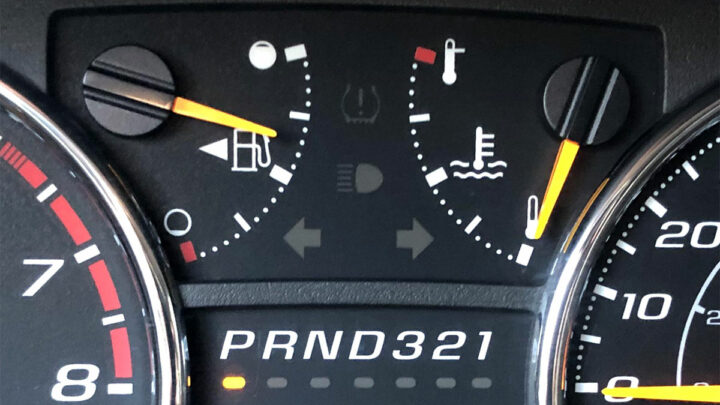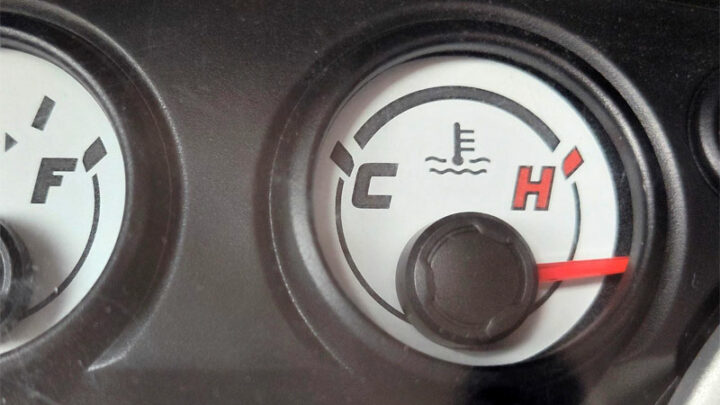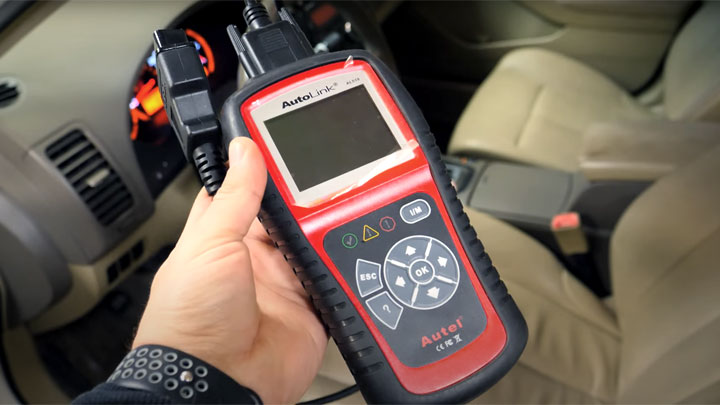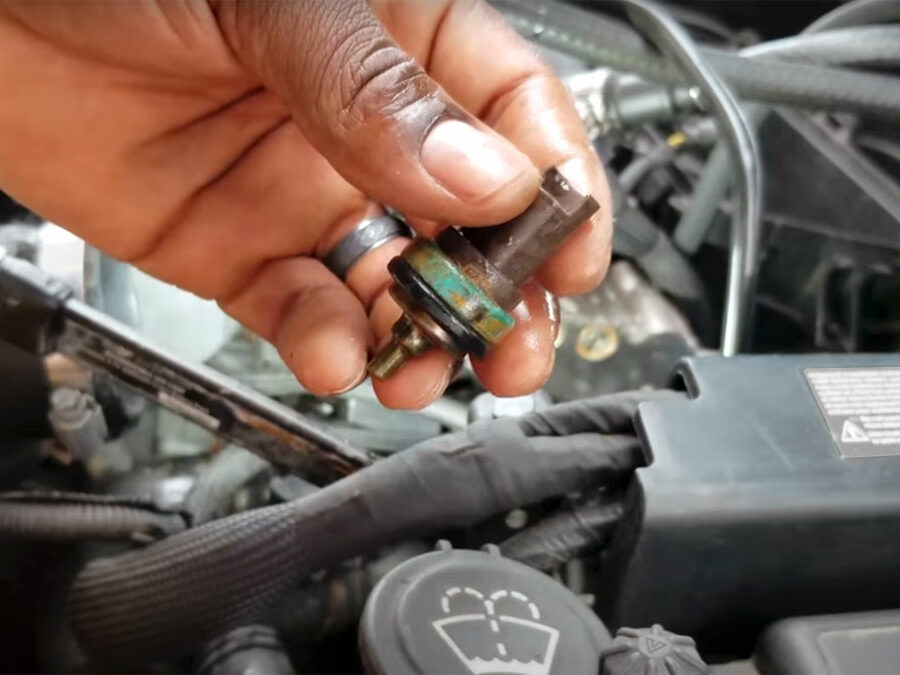Car Temperature Gauge Stopped Working? (Here’s Why)
You’re driving along and you notice that your temperature gauge isn’t moving after a few minutes of driving. Or maybe it suddenly flatlines.
Is your engine about to overheat? Is it just a simple malfunction with a quick fix or do you need to start planning for an expensive repair bill?
Read on to learn more about the causes of temperature gauge failure, whether it’s safe to continue driving, and how to diagnose the issue.

How a Temp Gauge Works
The typical automotive temperature gauge operates as a thermistor, varying internal resistance within a circuit based on the temperature of the heated surface to which its probe is affixed. The resistance within this circuit is higher when monitored temperatures are low, but drops significantly when temperatures rise.
Usable feedback is obtained by providing an engine’s ECT (Engine Coolant Temperature) sensor with a defined input voltage (5V).
When an engine is cold, this voltage is resisted to nominal levels. When warm, circuit resistance drops, and a higher rated output is achieved. The output signal from this sensor is read by a vehicle’s computer (ECM or PCM) and is displayed via the affected vehicle’s instrument cluster.
It is also worth noting that feedback from an engine’s coolant temperature sensor is used in calculating such important operating parameters as fuel and spark timing.
Therefore, you shouldn’t be led to believe that an improperly working engine temperature gauge is no big deal. When such feedback is lost, engine performance is sure to suffer.

Related: Temperature Gauge Rising, But Car Isn’t Overheating?
Causes of Temperature Gauge Failure
A vehicle’s temperature can fail for one of several different reasons, some of which tend to be far more difficult to isolate than others. Those familiar with such causes tend to be quite adept at diagnosing and fixing such issues.
Here are several of the most common causes of automotive temperature gauge failures.
#1 – Faulty Coolant Temperature Sensor

As previously discussed, a vehicle’s engine coolant temperature sensor is responsible for measuring engine temperatures while in operation. This sensor is generally located within close proximity to an engine’s thermostat and tends to be a moderately common point of failure in most engines.
When faulty, a vehicle’s temperature sensor might fail to record feedback as normal.
#2 – Compromised ECT Sensor Wiring
Damaged wiring within a vehicle’s engine coolant temperature sensor circuit can also cause a temperature gauge to appear inoperable. This is especially true in the event that the feedback wire of the circuit was to be “open”.
When this occurs, you’ll also note that your vehicle registers a newly illuminated check engine light.
#3 – Stuck/Damaged Gauge

Though somewhat rare, a stuck needle can also serve as the root cause of gauge-related issues, including those that exhibit themselves as not moving or otherwise inoperative gauge.
In many cases, the affected vehicle’s instrument cluster will have to be removed and repaired (or remanufactured).
#4 – Faulty ECM/PCM
Another rare cause of temperature gauge failure is an ECM/PCM that has become compromised. Since a vehicle’s ECM/PCM is responsible for interpreting ECT sensor feedback, the health of this module must be satisfactory, in order for proper gauge operation.
Nonetheless, all other potential causes of this type of issue should be thoroughly explored, before doubt is to be cast upon the ECM/PCM. It’s not common, but if the ECM or PCM is truly to blame, replacement and reprogramming costs often surpass $1,000.
Is It Safe to Continue Driving?

While most vehicles are able to be operated in the absence of a working temperature gauge, you should be extremely careful in doing so. This stems from the fact that the visibility of engine temperature readings is extremely important to efficient and responsible vehicle operation.
You must be able to recognize rises in engine temperature, and act accordingly, or else risk incurring severe engine damage.
Additionally, you may also find that vehicle operation and overall driveability suffers, whenever a digital or analog temperature reading is not presented.
Engine coolant temperature readings are extremely valuable to overall engine operation, and a lack thereof often leads to reduced or derated engine performance. One might even notice that their vehicle fails to start under certain conditions, with a faulty ECT sensor.
In any event, the root cause of a vehicle’s temperature gauge failure should be diagnosed and repaired as soon as possible. Doing so can possibly prevent future engine damage, and mitigate the risk of corresponding driveability-related issues.
If you’re unsure about handling these repairs on your own, it’s best to schedule a visit with a reliable repair shop as soon as possible.
Diagnosis and Repair
The following steps can be used to assist in diagnosing and repairing the root cause of engine temperature gauge failure. As always, it’s best to consult factory-specific service literature for your particular model of vehicle before attempting any such repairs.
#1 – Scan For Trouble Codes

Before delving into the diagnostic process itself, you should check for the presence of any active diagnostic fault codes with the use of an OBD-II scan tool. Any faults that are present should be thoroughly diagnosed before proceeding.
#2 – Check Live Temperature Readings
Again, with the use of a quality scan tool, check for ECT sensor feedback immediately after taking a short drive.
If these readings appear in range when compared to those specified by the vehicle’s manufacturer, then you should focus your efforts on verifying the integrity of the vehicle’s instrument cluster and related circuits.
#3 – Inspect ECT Sensor and Wiring

If previous testing revealed questionable temperature sensor readings, then a close visual inspection of the coolant temperature sensor and related wiring is warranted. Carefully check for obvious signs of damage to the ECT sensor, while also inspecting the condition of the plug’s connector.
All related wiring should also be traced by hand, and thoroughly inspected. While beneath the hood, it is also a good idea to make sure that your engine’s coolant is adequately topped off.
#4 – Test ECT Sensor
If no visual signs of damage were evident, your vehicle’s ECT sensor needs to be checked, in accordance with applicable factory-specific service literature for that vehicle.
This type of testing will require inlet/outlet voltage checks, as well as resistance testing across the sensor itself. Any condemnable readings will ultimately necessitate ECT sensor replacement.
- 5 Symptoms of an EVAP Leak (and Repair Cost) - Apr 27, 2024
- P0480 Code (Symptoms, Causes, and How to Fix) - Apr 19, 2024
- Car Temperature Gauge Stopped Working? (Here’s Why) - Apr 15, 2024
